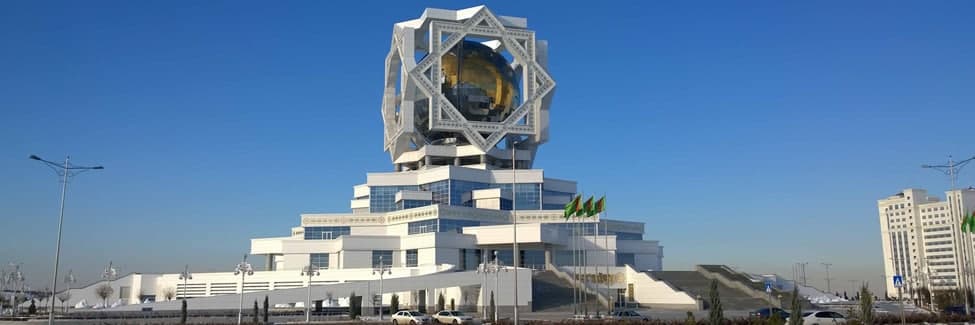Turkmanistan

Turkmenistan is located at the center of the Eurasian continent and has been classified as an upper-middle-income country since 2012. It borders Kazakhstan, Uzbekistan, Iran, Afghanistan, and, to the west of the country, the Caspian Sea, which offers abundant natural resources of gas and oil deposits.
Turkmenistan’s gas reserves are estimated to be the world’s fourth largest, representing about 10 percent of global reserves. In addition to cotton and natural gas, the country is rich in petroleum, sulfur, iodine, salt, bentonite clays, limestone, gypsum, and cement—all potential inputs to chemical and construction industries.
Country Context
|
Turkmanistan |
2018 |
|
Population, million |
5.8 |
|
GDP, current US$ billion |
40.8 |
|
GDP per capita, current US$ |
7,065 |
|
Life Expectancy at Birth, years |
67.8 |
Source: World Bank data, www.worldbank.org
September 27, 1991, is marked in Turkmenistan as Independence Day. On December 12, 1995, Turkmenistan was recognized as a permanently neutral State by the resolution of the UN General Assembly with the unanimous support of 185 member States. At present, Turkmenistan has established diplomatic relations with 149 countries.
Turkmenistan is a democratic, law-based, secular State. The form of government is a Presidential republic. The political structure of the Turkmen state is formed by the Constitution of Turkmenistan, adopted on May 18, 1992 (revised on September 14, 2016). The Сonstitution of Turkmenistan is the basic law of the State. According to that law, Turkmenistan’s state structure is based on the separation of powers into legislative, executive, and judicial branches, which act independently and balance each other. Constitutionally fixed norms and provisions are directly applicable. Laws and other legal acts that contradict the Constitution have no legal force.
The people of Turkmenistan are the bearers of sovereignty and the sole source of State power.

The President of Turkmenistan is the highest official of Turkmenistan. He is the Head of the State and executive power. The President of Turkmenistan chairs the Cabinet of Ministers – the Government of Turkmenistan. The President of Turkmenistan is the guarantor of the country’s independence and neutral status of Turkmenistan, its territorial integrity; respect for the Constitution; and the fulfillment of international obligations. The President of Turkmenistan is the Supreme Commander of the Armed Forces of Turkmenistan. Milli Gengesh of Turkmenistan (The Parliament) is a representative body having legislative authority. Milli Gengesh consists of 56 members, 48 of which are elected from each velayat (region) and the city of Ashgabat based on the indirect electoral right by secret voting at the Halk Maslakhaty (People’ Council) sessions in the regions, Ashgabat, and the President of Turkmenistan appoints eight.
Mejlis is composed of 125 deputies elected based on general, equal, and direct electoral rights through secret ballot.
Judicial power in Turkmenistan resides solely in the courts. The judicial branch is meant to safeguard the rights and freedoms of citizens and the legally protected interests of the State and society.
The territory of Turkmenistan covers 491 21 thousand sq km. Its territory stretches for 1100 km from west to east and extends for 650 km from north to south. In the north, Turkmenistan borders the Republic of Kazakhstan. In the northeast and the east, Turkmenistan shares borders with the Republic of Uzbekistan. In the south-east, Turkmenistan borders with the Islamic Republic of Afghanistan, and the south – with the Islamic Republic of Iran. In the west, the country’s natural boundary is the Caspian Sea, through which Turkmenistan borders with the Republic of Azerbaijan.
The population of Turkmenistan is more than 6.2 million people. Turkmenistan is a multinational state. More than 100 nations are living in the country.
The Turkmen language is the state language. The use of their native language is guaranteed to all citizens of Turkmenistan. The educational institutions of Turkmenistan ensure the learning of three languages – Turkmen, English, and Russian. In addition, the higher educational institutions and some specialized secondary schools include French, Chinese, German, Japanese, and some other foreign languages.

The capital city of Turkmenistan is Ashgabat, which is an administrative and territorial unit with province-wide powers (velayat). Ashgabat consists of 4 districts (etraps): Bagtyyarlyk district, Berkararlyk district, Kopetdag district, Buzmeyin district.
Turkmenistan is divided into 5 provinces – Ahal, Balkan, Dashoguz, Lebap, and Mary. Each province is divided into districts. There are 43 districts, 6 etraps within towns, 51 towns, 11 towns with etrap rights, 62 villages and 605 rural councils (rural municipal units), and 1719 rural settlements in Turkmenistan.
Although in July 2019 Turkmenistan signed a five-year contract with the Russian Federation to supply natural gas, the resumed volumes will be significantly lower than three years ago, making China the largest market for Turkmenistan’s hydrocarbon exports. Additionally, the country is in the process of constructing the Turkmenistan-Afghanistan-Pakistan-India (TAPI) pipeline. Gas exports to other regions through gas swap mechanisms would help diminish the risk of overreliance on a single client.
Tight administrative controls and the public sector’s dominant role in economic activity have hindered private sector development. Despite the growth of the private sector’s share in segments of the economy, public sector and state-owned monopolies continue to govern the economy and the formal labor market. Apart from the hydrocarbon sector, foreign direct investment (FDI) remains limited.
Opening the economy, improving the business regulatory environment, accelerating the corporatization and privatization of state-owned enterprises (SOEs), and investing more heavily in human capital would be vital to boosting private sector development and achieving medium- and long-term national development goals.




